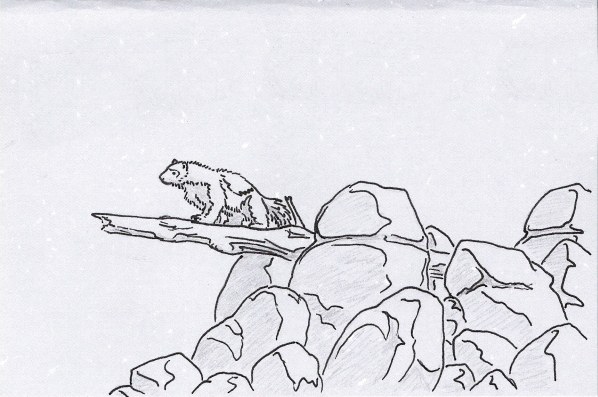Mustelids in GURPS
 The mustelids are a diverse group of exceptionally tough carnivores. Typically short legged and long bodied, they lack speed but have radiated into a large number of lifestyles that do not require fleetness of foot; from tiny tunnel hunters to diggers, tree-top leapers, swimmers, and arctic scavengers. They have spread across the globe to all continents except Antarctica and Australia.
The mustelids are a diverse group of exceptionally tough carnivores. Typically short legged and long bodied, they lack speed but have radiated into a large number of lifestyles that do not require fleetness of foot; from tiny tunnel hunters to diggers, tree-top leapers, swimmers, and arctic scavengers. They have spread across the globe to all continents except Antarctica and Australia.
A mustelid's primary sense is smell. They use this to recognize objects; detect threats, food, rivals, and mates; and to track down prey. Hearing comes in second in terms of importance. Their vision is generally geared more toward detecting motion than recognizing things, and they often present a rather myopic appearance as they peer about trying to locate something that they smell or heard. The sense of touch of the mustelids is acute, centered primarily on the face and based on the long whiskers that sprout from their lips, chin, and brow. These whiskers allow them to precisely target their prey's vital spots even in complete darkness.
Mustelids are well known for their stinky musk, which they spray when upset. Even when they do not spray, they have a distinctive, musky odor. Many people find this offensive, some don't mind it, and a few even enjoy the smell. One group, the skunks, have developed this spray into a potent weapon. Other species rely less on smelling bad for defense and more on bad attitude, strength, agility, perseverence, tough skin, sharp teeth, reputation, and sheer staying power. Their bodies are essentially tubes of pure muscle, giving them a high strength for their size. They also have fast reflexes, amazing agility, and bodies so flexible they seem made of rubber. When grabbed or bitten, they can turn clear around inside their loose fitting skin so that a dog or man that thought it had a mustelid by the neck soon finds himself holding a bristing, biting, and clawing critter on some completely different portion of its anatomy - a portion that allows the mustellid's full arsenal of natural weapons to be employed to maximum effect (in game terms, this is represented by the Slippery advantage).
Those mustelids that hunt large prey (relative to their body size) will grab their victim with a bite, then grip it with either the forelegs or wrap the whole body around it. This allows them to position themselves for a death bite - delivered precisely through the base of the skull, driving their elongated fangs into the brain. Once killed, specialized blade-like molars and premolars called carnassals are employed to slice off flesh to eat.
Mustelids have attitude to spare. They are fearless, atacking things much bigger than themselves and often refusing to back down from overwhelming odds. They tend towards hyperactivity, have an insatiable curiosity, and remain fun-loving and playful throughout their lives. Many can get quite cranky if bothered, launching savage attacks on the hapless interloper. If presented with an opportunity to kill, many species go into a blood frenzy, slaying everything in sight.
If taken when young, mustelids make charming pets, being affectionate, energetic, and playful. Their curiosity, great strength and agility, and hyperactivity, however, make them wearisome and destructive. However lovable it may be, few people are willing to tolerate a badger that digs through their sofa or the floor of their house, or an otter that tears down anything it can reach to play with and turns on the water taps to leave the house to be flooded.
Game Statistics
| choose a species:
|
|
Species
| Male
| Female
| (optional)
enter weight (kg)
| Captive?
| T? | HR? | |
| |
The radio button entries in the table above give typical sizes of the mustelid species of the selected sex. If you want a larger or smaller specimen, enter the weight in kg manually.
The Captive checkbox is for animals that have been kept in captivity all their lives, without the ability to hone their reflexes, muscles, and skills like thier wild relatives. It would be appropriate for most pet ferrets or a zoo animal.
Marking the T? checkbox will give you the stats in template form with all costs listed, otherwise you get a stat sheet as for a character.
Marking the HR? checkbox will print the information using all my house rules. Otherwise, the stats will be as compatable with plain vanilla GURPS as possible (although several custom advantages and disadvantages will be present, see my Traits page).
|
Back to Animalia
 The mustelids are a diverse group of exceptionally tough carnivores. Typically short legged and long bodied, they lack speed but have radiated into a large number of lifestyles that do not require fleetness of foot; from tiny tunnel hunters to diggers, tree-top leapers, swimmers, and arctic scavengers. They have spread across the globe to all continents except Antarctica and Australia.
The mustelids are a diverse group of exceptionally tough carnivores. Typically short legged and long bodied, they lack speed but have radiated into a large number of lifestyles that do not require fleetness of foot; from tiny tunnel hunters to diggers, tree-top leapers, swimmers, and arctic scavengers. They have spread across the globe to all continents except Antarctica and Australia.